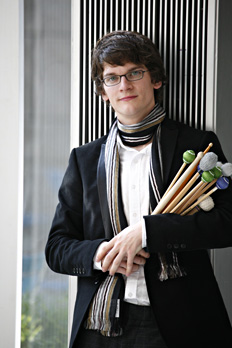
Chinese gongs, metal blocks, thunder sheets, drums of all kinds – already before yesterday evening’s concert, the stage in the domed hall at the Dresdner Bank offered an illustrious sight. Already with the first cymbal stroke, Johannes Fischer staged his own choreography to pieces by contemporary composers such as Iannis Xenakis, Gerald Eckert, George Aperghis and Dieter Mack. Nothing was left to chance; each note from the score was precisely realised. The first piece by Dieter Mack reflected the character of the CD “Traces” (Spuren) presented at the concert; each instrument on the stage had its own cultural history, its own origin – the composer Dieter Mack, a cosmopolitan, brought his many years of experience with Indonesian music into his own composing.
Then, a composition by Gerald Eckert was particularly stimulating, for the composer was himself present and ready to answer questions, e.g. “Is everything precisely notated, did you have an idea of the sound of the piece beforehand, do you compose at a desk?” The mathematician, physicist and composer Gerald Eckert gave a good account for himself. In his piece “nor,” the percussion instruments is reinterpreted and alienated; soft or shimmering tones arise from a mere stroke of a bow, whirring overtones are coaxed from the thunder sheet – an instrument mostly used in operas orchestras for tone-painting effects. Novel sound masses are created together with the tam-tams and Tibetan cymbal.
The dramaturgy of the concert became ever more intense towards the end, with the pieces becoming shorter, faster and more virtuosic. The rhythmical “Le corps à corps” was cast in a comical light. A newspaper article about an automobile accident, adapted for percussive speaking voice and an exotic percussion instrument called the zarb. One could catch episodic fragments of French words concerning the bloodthirsty event in the babble of voices, illustrated and interrupted by rhythmic accents.
“Rebonds B” by Iannis Xenakis then provided the virtuosic climax of the evening, a piece with a single crescendo in tempo and rhythmic interweaving. One could hardly bear to watch the flying drum-beaters in the hands of ARD prize winner Johannes Fischer; the piece pursued his drive at breathtaking speed right up to the end! There was wild applause from the enthusiastic listeners, who then had their GENUIN CDs signed by Johannes Fischer. They could then admire the original scores, gaining further insights into the New Music over wine and pretzels.
This was an evening that made one want more, for Johannes Fischer, Gerald Eckert and moderator Tobias Wolff, in their discussion, also knew very well how to initiate the audience into the secrets of unknown, exotic and sometimes also very quiet New Music. Compliments to the audience as well!
Chinese gongs, metal blocks, thunder sheets, drums of all kinds – already before yesterday evening’s concert, the stage in the domed hall at the Dresdner Bank offered an illustrious sight. Already with the first cymbal stroke, Johannes Fischer staged his own choreography to pieces by contemporary composers such as Iannis Xenakis, Gerald Eckert, George Aperghis and Dieter Mack. Nothing was left to chance; each note from the score was precisely realised. The first piece by Dieter Mack reflected the character of the CD “Traces” (Spuren) presented at the concert; each instrument on the stage had its own cultural history, its own origin – the composer Dieter Mack, a cosmopolitan, brought his many years of experience with Indonesian music into his own composing.
Then, a composition by Gerald Eckert was particularly stimulating, for the composer was himself present and ready to answer questions, e.g. “Is everything precisely notated, did you have an idea of the sound of the piece beforehand, do you compose at a desk?” The mathematician, physicist and composer Gerald Eckert gave a good account for himself. In his piece “nor,” the percussion instruments is reinterpreted and alienated; soft or shimmering tones arise from a mere stroke of a bow, whirring overtones are coaxed from the thunder sheet – an instrument mostly used in operas orchestras for tone-painting effects. Novel sound masses are created together with the tam-tams and Tibetan cymbal.
The dramaturgy of the concert became ever more intense towards the end, with the pieces becoming shorter, faster and more virtuosic. The rhythmical “Le corps à corps” was cast in a comical light. A newspaper article about an automobile accident, adapted for percussive speaking voice and an exotic percussion instrument called the zarb. One could catch episodic fragments of French words concerning the bloodthirsty event in the babble of voices, illustrated and interrupted by rhythmic accents.
“Rebonds B” by Iannis Xenakis then provided the virtuosic climax of the evening, a piece with a single crescendo in tempo and rhythmic interweaving. One could hardly bear to watch the flying drum-beaters in the hands of ARD prize winner Johannes Fischer; the piece pursued his drive at breathtaking speed right up to the end! There was wild applause from the enthusiastic listeners, who then had their GENUIN CDs signed by Johannes Fischer. They could then admire the original scores, gaining further insights into the New Music over wine and pretzels.
This was an evening that made one want more, for Johannes Fischer, Gerald Eckert and moderator Tobias Wolff, in their discussion, also knew very well how to initiate the audience into the secrets of unknown, exotic and sometimes also very quiet New Music. Compliments to the audience as well!









